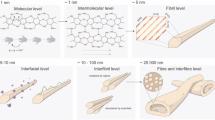Abstract
The hypothesis advanced in this issue of CELLULOSE [Springer] by Bjorn Lindman, which asserts that the solubility or insolubility characteristics of cellulose are significantly based upon amphiphilic and hydrophobic molecular interactions, is debated by cellulose scientists with a wide range of experiences representing a variety of scientific disciplines. The hypothesis is based on the consideration of some fundamental polymer physicochemical principles and some widely recognized inconsistencies in behavior. The assertion that little-recognized (or under-estimated) hydrophobic interactions have been the reason for a tardy development of cellulose solvents provides the platform for a debate in the hope that new scientific endeavors are stimulated on this important topic.

Similar content being viewed by others
References
Atalla RH (1983) The structure of cellulose: recent developments. In: Soltes EJ (ed) Wood and agricultural residues. Academic Press New York, London, p 59
Bergenstråhle M, Wohlert J, Himmel ME, Brady JW (2010) Simulation studies of the insolubility of cellulose. Carbohydr Res 345:2060–2066
Burchard W, Habermann N, Klüfers P, Seger B, Wilhelm U (1994) Cellulose in Schweizer’s reagent: a stable, polymeric complex with high chain stiffness. Angew Chem Int Educ 33:884
Cousins SK, Brown RM Jr (1995) Cellulose I microfibril assembly: computational molecular mechanics energy analysis favours bonding by van der Waals forces as the initial step in crystallization. Polymer 36:3885–3888
Cousins SK, Brown RM Jr (1997a) X-ray diffraction and ultrastructural analyses of dye-altered celluloses support van der Waals forces as the initial step in cellulose crystallization. Polymer 38:897–902
Cousins SK, Brown RM Jr (1997b) Photoisomerization of a dye-altered β-1, 4 glucan sheet induces the crystallization of a cellulose-composite. Polymer 38:903–912
Cui W, Wood PJ, Blackwell B, Nikiforuk J (2000) Physicochemical properties and structural characterization by two-dimensional NMR spectroscopy of wheat β-D-glucan in comparison with other cereal β-D-glucans. Carbohydr Polym 41:249
Esker A, Becker U, Jamin S, Beppu S, Renneckar S, Glasser WG (2004) Self-assembly behavior of some co- and hetero-polysaccharides related to hemicellulose. ACS Symp. Ser. No. 864, 198–219
Flory PJ (eds) (1953) Statistical thermodynamics of polymer solutions. In: Principles of polymer chemistry, Chapter 12. Cornell University, Ithaca and London, p 495
French AD, Miller DP, Aabloo A (1993) Miniature crystal models of cellulose polymorphs and other carbohydrates. Int J Biol Macromol 15:3036
French AD, Dowd MK, Cousins SK, Brown RM, Miller DP (1995) Molecular deformations and lattice energies of models of solid saccharides. ACS Symp Ser 618, 1337
Fuchs R, Habermann N, Klüfers P (1993) Sandwichartige Mehrkernkomplexe aus deprotoniertem β-cyclodextrin und Kupfer II-Ionen. Angew Chem 105:895
Glasser WG (2008) Cellulose and associated heteropolysaccharides. In: Fraser-Reid B, Tatsuta K, Thiem J (eds) Glycoscience, Chapter 6.3. Springer-Verlag, Berlin Heidelberg, pp 1473–1512
Gradwell SE, Renneckar S, Esker AR, Heinze Th, Gatenholm P, Vaca-Garcia C, Glasser WG (2004) Surface modification of cellulose fibers: towards wood composites by biomimetics. CR Biol 327(9–10):945–953
Haigler C, Brown RM Jr, Benziman M (1980) Calcofluor White ST alters the in vivo assembly of cellulose microfibrils. Science 210:903–906
Haigler CH, White AR, Brown RM Jr, Cooper KM (1982) Alteration of in vivo cellulose ribbon assembly by carboxymethyl-cellulose and other cellulose derivatives. J Cell Biol 94:64–69
Kaya A, Drazenovich DA, Glasser W, Heinze T, Esker A (2009) Hydroxypropyl xylan self-assembly at air/water and water/cellulose interfaces. ACS Symp. Ser. #1019, 171–191
Kaya A, Du X, Liu Z, Wu JW, Morris JR, Glasser WG, Heinze T, Esker AR (2009b) Surface plasmon resonance studies of pullulan cinnamate adsorption onto cellulose. Biomacromolecules 10:2451–2459
Klüfers P, Mayer P, Schumacher JZ (1994) Linear coordination polymers of copper II and fourfold deprotonated sugar alcohols. Angw Chem Int Educ 33:1742
Koshijima T, Watanabe T (2003) Association between lignin and carbohydrates in wood and other plant tissues. Springer, New York, p 329
Le Moigne N, Bikard J, Navard P (2010) Contraction and rotation and contraction of native and regenerated cellulose fibres upon swelling and dissolution: the role of stress unbalance. Cellulose 17(3):507–519
Medonca S, Johnson GP, French AD, Laine RA (2002) Conformational analyses of native and permethylated disaccharides. J Phys Chem A 106:4115–4124
Medronho B, Ramano Q, Graca Miguel MA, Stigsson L, Lindman B (2012) Rationalizing cellulose (in)solubility: reviewing basic physicochemical aspects and role of hydrophiobic interactions. Cellulose. doi:10.1007/s10570-011-9644-6
Nishiyama Y, Langan P, Chanzy H (2002) Crystal structure and hydrogen-bonding system in cellulose Iβ from synchrotron X-ray and neutron fiber diffraction. J Am Chem Soc 124:9074–9082
Nishiyama Y, Johnson GP, French AD (2012) Diffraction from nonperiodic models of cellulose crystals. Cellulose. doi:10.1007/s10570-012-9652-1
Parthasarathi R, Bellesia G, Chundawat SPS, Dale BE, Langan P, Gnankaran S (2011) Insights into hydrogen bonding and stacking interactions in cellulose. J Phys Chem A 115:14191–14202
Pincu M, Cocinero EJ, Mayorkas N, Brauer B, Davis B, Gerber RB, Simons JP (2011) Isotopic hydration of cellobiose vibrational spectroscopy and DYNAMICAL simulations. J Phys Chem A 115:9498
Saalwächter K, Burchard W, Klüfers P, Mayer P, Klemm D, Dugarmaa S (2000) Cellulose in water containing metal complexes. Macromolecules 33:4094
Smith DC, Glasser WG, Glasser HR, Ward TC (1988) Simulation of reactions with lignin by computer (SIMREL) VII. About the gel structure of lignin. Cellul Chem Technol 22:171–190
Sponsler OL (1931) Orientation of cellulose space lattice in the cell wall, additional X-ray data from Valonia cell-wall. Protoplasma 12:241–255
Tanford C (1973) The hydrophobic effect. Wiley, New York
Warwicker JO, Wright AC (1967) Function of sheets of cellulose in swelling reactions on cellulose. J Appl Polym Sci 11:659–671
Westbye P, Koehnke T, Glasser W, Gatenholm P (2007) The influence of lignin on the self-assembly behaviour of xylan rich fractions from birch (Betula pendula). Cellulose 14(6):603–613
Wood P, Fulcher RG, Stones BA (1983) Studies on the specific interaction of cereal cell wall components with congo red and calcofluor specific detection and histochemistry of (1–3),(q-4). β-D-glucan. J Cereal Sci 1:95
Author information
Authors and Affiliations
Corresponding author
Rights and permissions
About this article
Cite this article
Glasser, W.G., Atalla, R.H., Blackwell, J. et al. About the structure of cellulose: debating the Lindman hypothesis. Cellulose 19, 589–598 (2012). https://doi.org/10.1007/s10570-012-9691-7
Received:
Accepted:
Published:
Issue Date:
DOI: https://doi.org/10.1007/s10570-012-9691-7




